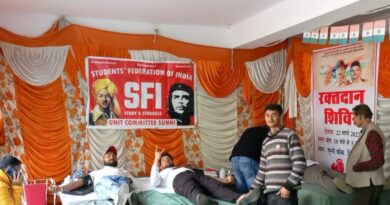Uproar Against Proposed Mega Hydroelectric Projects in Lahaul Massive Protest Rally Announced in Udaipur on 23rd May
Today, under the leadership of panchayat representatives from Udaipur subdivision in Lahaul, Sudarshan Jaspa, President of the Lahaul Spiti Ekta Manch, sounded the bugle for a movement against nearly one and a half dozen major hydroelectric projects proposed in the Chenab basin of Lahaul Valley. These projects include Jispa (300 MW), Stegri (98 MW), Chatru (120 MW), Mayar (120 MW), Tandi (104 MW), Raskell (130 MW), Seli (400 MW), Shangling (44 MW), Teling (94 MW), Bardang (126 MW), Tingret (81 MW), Gondhla (144 MW), Koksar (90 MW), Raholi Dugli (420 MW), Purthi (300 MW), Sach Khas (260 MW), and Duggar (380 MW). No area of Lahaul Valley will remain untouched by these projects.
Sudarshan Jaspa strongly opposed the recent Memorandum of Understanding (MoU) signed by the Himachal government with the Telangana government for the Mayar (120 MW) and Seli (400 MW) projects, stating that this decision completely ignores the highly sensitive geographical conditions, climate, and tribal rights of the entire Lahaul Valley. He warned that the construction of these projects would not only destroy the fertile land, biodiversity, and endangered species of the valley but could also forcibly displace the residents of Lahaul, who are already living in extreme geographical conditions.
He cited examples like Kinnaur and Uttarakhand, where massive blasting, tunnel construction, and debris dumping for similar large-scale projects have led to devastating landslides and floods. The Dr. Ravi Chopra Committee, formed to investigate the causes of the 2013 Uttarakhand disaster, held large hydroelectric projects responsible for the tragedy. Similarly, in 2009, the Abhay Shukla Committee, constituted by the Honorable High Court of Himachal Pradesh, recommended a complete ban on such projects in high-altitude Himalayan regions above 7,000 feet, citing environmental destruction. The National Disaster Management Authority (NDMA) has also deemed these projects unsuitable for high Himalayan zones.
Lahaul Valley’s average altitude is around 9,000 feet above sea level, which is 2,000 feet higher than the limit recommended by the Abhay Shukla Committee. Additionally, the district falls under seismic risk zones 4 and 5, making it highly vulnerable to earthquakes. In recent years, extreme weather changes have already caused devastating floods in several areas like Mayar, Jahalma, Shansha, Tozing, and Shaks. Given these risks, it is imperative for the entire valley to unite against these projects.
In light of this, a massive protest rally will be held on 23rd May 2025 at 11 AM at the Mrikula Mata Temple grounds in Udaipur, led by panchayat representatives. They have urged all women’s groups, youth organizations, social groups, and intellectuals of Lahaul-Spiti to join the rally and raise their voices for the valley’s future.
Present at the press conference were Zila Parishad member Mahinder Singh, BDC members Sheela Devi and Rita Thakur, Rakesh, and several village heads including Lakshman Thakur, Dinesh Kumar, Hirchand, Gopal Gaud, Nirmala, Vikas Jaspa, Khushal Chand, Surender Thakur, Premdasi, and Ravinder, among others.
As per Guman Singh from Himalaya Niti Abhiyan ” The transfer of 20,000 hectares (88 square miles) of land in Pang (Kyangchuthang) by Ladakh UT to the ‘Solar Power Corporation of India’ for generating 15,000 megawatts of electricity . From Pang, this ready-to-use electricity will be plugged into North India’s grid (via the ‘Power Grid Corporation of India’ at a cost of ₹21,000 crores) by crossing the Baralacha, Rohtang, and two other passes in the Ladakh region—then through Lahaul-Kullu-Mandi-Bilaspur-Kiratpur, reaching Kaithal.
Shouldn’t there also be a dialogue about the massive displacement and devastation caused by the acquisition of 500 times more land (compared to the 200 MW power transmission from Manali to Bajaura) for the series of towering power towers and the heavy web of transmission lines across these areas? These will swallow our gardens, farmlands, and village lands.
What do you say about this issue? The investment is in Ladakh, but the suffering falls on us—the people of Himachal. The matters of Shinkula, Sarchu, and other interstate borders will eventually be resolved through dialogue.”



